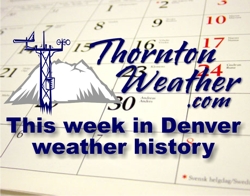
An extremely eventful week in weather history showing just how varied conditions can be. We of course see typical spring weather like tornadoes and hail but also a touch of snow and this week also marks the anniversary of the start of the Hayman Fire.
2-7
In 1921…heavy rainfall for nearly a week…on top of streams already swollen by mountain snowmelt…produced widespread flooding over the South Platte River basin…including the tributaries through the canyons to the west and southwest of Denver. Heavy rainfall over the 6-day period totaled 3.36 inches in Boulder…4.98 inches in Morrison…4.27 inches in Castle Rock…and 2.94 inches in the city of Denver. Rainfall amounts in the foothills were estimated between 3 and 6 inches. The narrow-gage tracks of the Colorado and southern railroad were destroyed in the Platte Canyon. From the mouth of the canyon through the city to near Brighton… The river spread from 1/2 to nearly 1 1/2 miles wide… Flooding farm and pasture land and destroying or damaging many bridges. In the city…many businesses along with as many as 500 homes were inundated…forcing their evacuation. Bridges were swept away. The high waters flooded the rail yards and stock yards in lower downtown…closing three adjacent packing houses. The heavy rains also caused flooding on Boulder creek in Boulder on the 6th.
6-7 in 2004…a brief hot spell produced 3 temperature records. High temperatures of 95 degrees on the 6th and 98 degrees on the 7th were record maximum temperatures for the dates. Low temperature of 68 degrees on the 7th was a record high minimum for the date.
In 2007…an unusually strong storm system brought very strong winds to the Front Range foothills and urban corridor. Peak gusts included: 92 mph at Boulder…85 mph…2 miles southwest of Boulder…83 mph…10 miles south of Boulder and 55 mph at Denver International Airport. High winds forced the closure of Mt. Evans Road and Trail Ridge Road. Several trees were uprooted across the urban corridor. In Aurora… The driver of a car was injured when some building material blew off the Fitzsimmons complex. The debris landed on the car and knocked the driver unconcious. The wind forced the cancellation of 60 flights at Denver International Airport. Xcel reported outages in Boulder…Denver…Lakewood and Longmont.
7
In 1904…a thunderstorm produced south winds to 40 mph with gusts to 50 mph…but only a trace of rain.
In 1942…heavy thunderstorm rainfall in south Denver caused flooding of shops…stalled motorists…and halted tramway service temporarily. Lightning damaged houses…but there was no loss of life. Precipitation totaled 0.53 inch in downtown Denver.
Continue reading June 7 to June 13 – This week in Denver weather history

